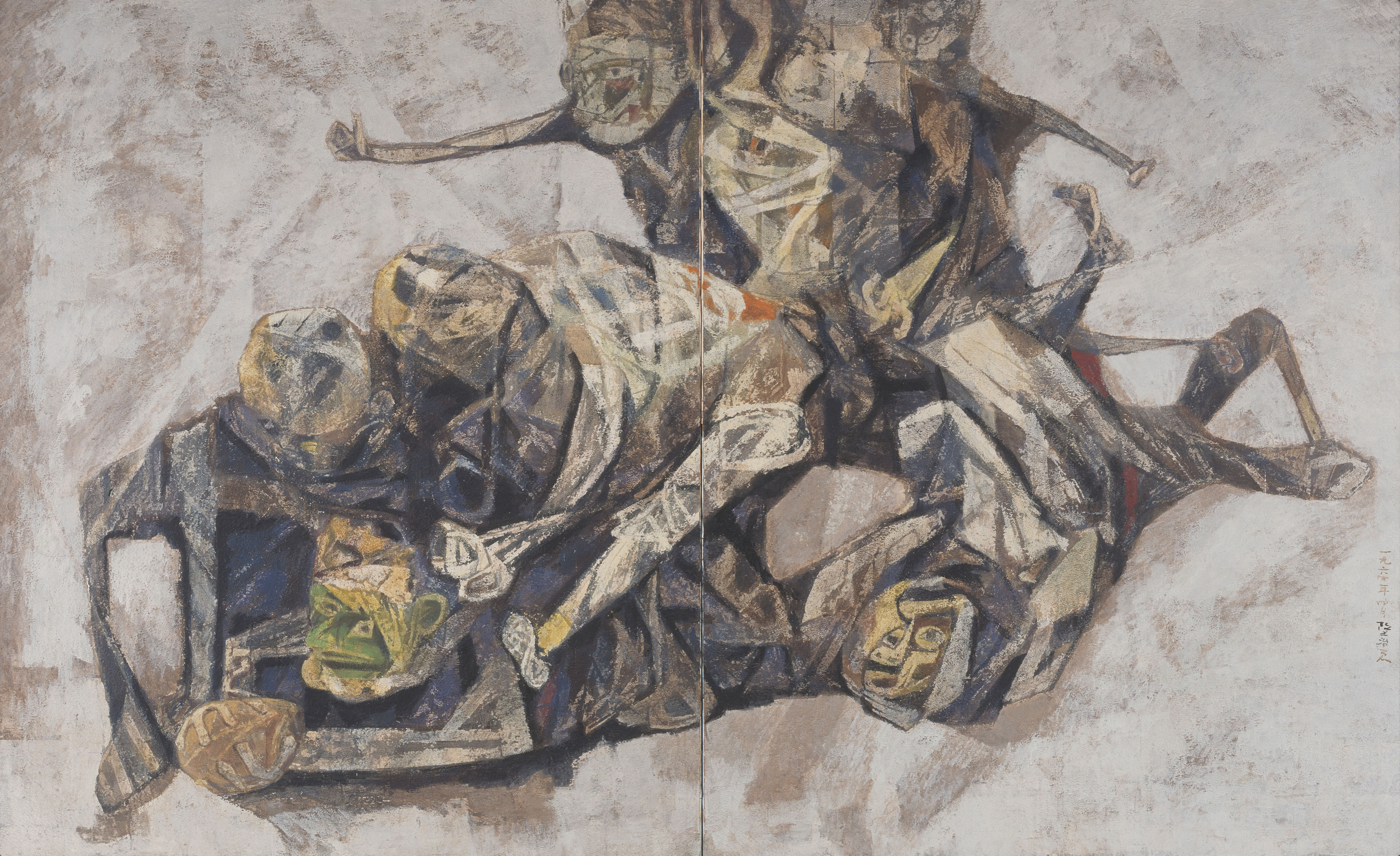
どうてきなぐんぞう 動的な群像
1964(昭和39年)
顔料/カンヴァス
まるでうごめく大きな生き物のようですが、画面左下のボールを両手で挟みこみ、歯を食いしばるような人物が見えると、彼の周囲に折り重なり合う人々の集団であることがわかります。ラグビーを題材とした本作品は、ボールに突進する選手たちの動きを、力強い描線で表しています。白く抽象化された背景が、その瞬間的な力強さや量感をいっそう際立たせています。
伝統的なものを重視してきた日本画の世界で、技法や素材の刷新を目指す団体に所属していた藤田。大のスポーツ好きでもあったという彼は、画題もまた従来の日本画にないものを求め、「近代スポーツ」という、当時としても野心的なモティーフをしばしばとりあげました。
本作は1964(昭和39)年、念願だった第六回現代日本美術展(毎日美術展)より出品委嘱を受け制作された作品。東京オリンピックも意識したこの年に、藤田は長年研究を重ねたスポーツという題材で、日本画の伝統に挑戦したのです。
藤田隆治【ふじた りゅうじ】
生没年 1907~1965(明治40年~昭和40年)
豊北町出身。同郷の高島北海に学び、のち上京して新美術人協会の創立に加わり、日本画革新の旗を担った画家です。1936年(昭和11)にはベルリン・オリンピックの芸術競技で銅メダルを受賞。写実的な作風から、戦後は絵具の質感をいかした幻想的な作風となり、スポーツや、故郷の海辺を主題とした作品を描きました。
| 寸法 | 162.0×260.7cm |
|---|---|
| 形状 | 額装 |

Active Figures
1964
Color on canvas
It seems at first glance as if a big, winged creature is depicted. But, when you recognize the person holding a ball with both hands, clenching his teeth, in the lower left part of the picture, you finally realize that this picture shows a man with a group of people lying on top of one another around him. This work, taking a rugby game as its subject, portrays with strong lines the movements of players rushing the ball. The abstract white background makes their instantaneous strength and appearance of massiveness even more striking.
In the world of Japanese-style painting, which has firmly emphasized tradition, Fujita Ryuji worked for a group that aimed at reforming painting techniques and materials. As a great lover of sports, he sought subjects not traditionally used in Japanese-sytle paintings, and often took “modern sports” as the subject of his paintings, an ambitious motif even in his time (the mid-20th Century). This work was produced at the request of the 6th Contemporary Art Exhibition of Japan (now the Mainichi Art Exhibition) and submitted to the exhibition in 1964, when the Tokyo Olympic Games were held in Japan. Fujita had had a long-cherished desire to be displayed in this exhibition.
Perhaps bearing in mind that Japan was hosting the Olympic Games for the first time, he voiced a protest against the tradition of Japanese-style painting with the theme of sports, which he had studied for a long time.
Fujita Ryuji (1907 – 1965)
Fujita came from Hohoku-cho (the present-day Shimonoseki City, Yamaguchi Prefecture). He learned to draw and paint under Hokkai Takashima, a painter from the same town. After that, he went to Tokyo and participated in the establishment of the Shin Bijutsujin Kyokai art society. As a painter, he carried the flag for revolutionizing the Japanese-style painting circle. He won a bronze medal in the Art Competitions of the Berlin Olympic Games held in 1936. From the realistic style he used in the pre-World War II period, he shifted to a fantastic style, making skillful use of the textures of paints in the days after the war, and used sports and the beach in his hometown as subjects of his paintings.
| Size | 162.0×260.7cm |
|---|

動的群像
1964
乍一看像一隻蠕動的龐大的生物,畫麵左下方可見雙手抱球,咬緊牙關的一個人,一些人疊加在其周圍。本作品以橄欖球為題材,用強有力的線條表現了選手們衝向球的動作瞬間。白色抽象化的背景,更凸顯了瞬間的力量及厚重感。
藤田隸屬於一個在重視傳統的日本畫界,以尋求創新技法與素材為目標的團體。藤田也非常愛好體育運動,並不斷尋求日本畫上前所未有的題材。“近代體育”就是他經常創作的,在當時也頗為大膽的畫題。
本作品是1964(昭和39)年,受心心念的第六屆現代日本美術展(每日美術展)之托,而製作的參展作品。在舉辦東京奧運會的這一年,藤田以多年潛心研究的體育題材,挑戰了傳統的日本畫。
藤田 隆治
生卒年 1907 ~ 1965(明治40年~昭和40年)
豐北町出身。向同鄉的高島北海拜師學藝,後來奔赴東京,參與了新美術人協會的創立,是一位肩負日本畫革新旗幟的畫家。1936年(昭和11年)在柏林奧運會藝術競賽中獲得銅牌。原本寫實的畫風,戰後轉變為具有顏料質感的幻想畫風,主要描繪以體育運動、故鄉的海邊為主題的作品。
| 尺寸 | 162.0×260.7cm |
|---|

동적인 군상
1964
마치 꿈틀거리는 거대한 생물체처럼 보이지만, 그림 좌측 하단에서 공을 양손으로 붙잡고 이를 악물고 있는 듯한 인물을 발견하면서부터는 그 주위에 포개어진 사람들의 집단이 눈에 보이기 시작합니다. 럭비를 주제로 한 본 작품은 공을 향해 돌진하는 선수들의 움직임을 힘 좋은 선으로 표현하고 있습니다. 하얗고 추상적인 배경이, 강력하게 뿜어져 나오는 순간적인 힘이나 입체감을 한층 돋보이게 합니다.
전통적인 것을 중시해온 일본화 세계에서 기법이나 소재의 쇄신을 지향하는 단체에 소속되어 있었던 후지타. 스포츠의 광팬이기도 했던 그는, 그림의 주제를 정할 때도 종래의 일본화에 없는 것을 추구하였고, 당시로서는 야심적인 「근대 스포츠」라는 모티브를 조금씩 다루었습니다.
본 작품은 1964년(쇼와39년), 그가 염원하던 제6회 현대 일본 미술전(마이니치 미술전)에서 출품 위촉을 받아 제작한 작품입니다. 모두가 도쿄 올림픽에 대해 관심을 가지고 있던 그 해, 후지타는 긴 시간 연구를 거듭한 스포츠라는 주제로 일본화의 전통에 도전한 것입니다.
후지타 류지
생몰년 1907년 ~1965년 (메이지40년~쇼와40년)
호호쿠쵸 출신. 동향 출신인 다카시마 홋카이에게 그림을 배웠고, 나중에는 상경하여 신미술인협회를 창립하는데 힘을 보탭니다. 일본화 혁신에 앞장선 화가입니다. 1936년(쇼와11년)에는 베를린 올림픽 예술경기에서 동메달을 수상. 원래 그의 작풍은 사실적 묘사가 주를 이뤘지만, 제2차 세계대전 이후로는 물감의 질감을 살린 환상적인 작풍으로 변화하여, 스포츠나 고향의 바닷가 등을 주제로 한 작품을 그렸습니다.
| 치수 | 162.0×260.7cm |
|---|
